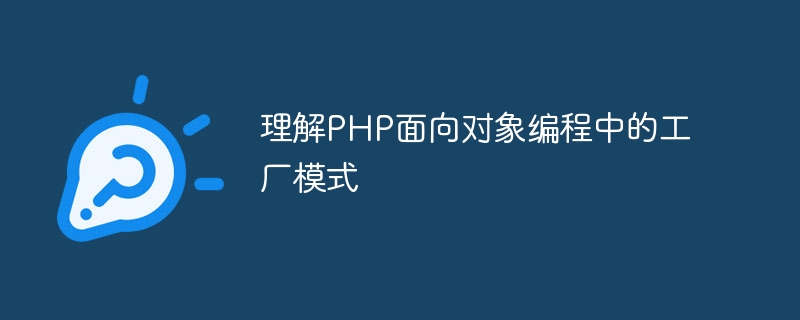Home >Backend Development >PHP Tutorial >Understand the factory pattern in PHP object-oriented programming
Understand the factory pattern in PHP object-oriented programming
- PHPzOriginal
- 2023-08-10 10:37:42910browse

Understand the factory pattern in PHP object-oriented programming
The factory pattern is a commonly used design pattern. It is used to combine the creation and creation of objects in the process of creating objects. Use decoupling. In PHP object-oriented programming, the factory pattern can help us better manage the creation and life cycle of objects. This article will introduce the factory pattern in PHP in detail through code examples.
In PHP, we can implement the object creation and initialization process by using the factory pattern instead of using the new keyword directly. The advantage of this is that if we need to change the way objects are created in the future, we only need to modify the code of the factory class without changing other parts.
First, let's look at a simple example. Suppose we have a class called "Product" that represents a product. We can create and use a Product object through the following code:
class Product
{
private $name;
public function __construct($name)
{
$this->name = $name;
}
public function getName()
{
return $this->name;
}
}
$product = new Product("Apple");
echo $product->getName(); // 输出:AppleIn the above code, we directly use the new keyword to create the Product object and pass in a name parameter to it. Although this method is simple and fast, if you need to change the way of creating Product objects in the future, such as obtaining data from a database, this method of directly creating objects will not be able to meet the needs.
Next, we will use the factory pattern to improve the above code. First, we define a factory class named ProductFactory for creating and initializing Product objects:
class ProductFactory
{
public static function create($name)
{
return new Product($name);
}
}In the above code, we define a static method named create for creating Product objects and returning . In this way, we can encapsulate the object creation process in the factory class without using the new keyword directly in the code.
Now, we can create and use the Product object through the following code:
$product = ProductFactory::create("Apple");
echo $product->getName(); // 输出:AppleThrough the above code, we can see that the Product object can be created by simply calling the create method of ProductFactory, and perform related initialization operations. In this way, we can easily change the way objects are created without changing other parts of the code.
In addition to simply creating objects, the factory pattern can also be used to create more complex objects. For example, we can create a database connection object through the factory pattern. The following is a simple example:
class DatabaseConnection
{
private $host;
private $username;
private $password;
public function __construct($host, $username, $password)
{
$this->host = $host;
$this->username = $username;
$this->password = $password;
}
// 省略一些数据库相关操作的方法...
}
class DatabaseConnectionFactory
{
public static function create($host, $username, $password)
{
return new DatabaseConnection($host, $username, $password);
}
}
$connection = DatabaseConnectionFactory::create("localhost", "root", "password");Through the above code, we can see that through the factory pattern, we can easily create and configure database connection objects and use them where needed. In this way, we can encapsulate the complex creation and initialization process in the factory class, making the code more concise and easier to maintain.
To sum up, the factory pattern is a design pattern commonly used in PHP object-oriented programming. It can help us better manage the creation and life cycle of objects. By using the factory pattern, we can encapsulate the object creation process in a factory class to achieve decoupling and reuse of objects. I hope that through the code examples in this article, readers can have a more in-depth understanding and application of the factory pattern in PHP.
The above is the detailed content of Understand the factory pattern in PHP object-oriented programming. For more information, please follow other related articles on the PHP Chinese website!

